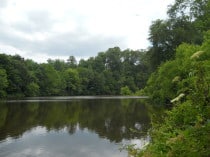Our Land and Water is a campaign to protect our region’s drinking water and to help restore the Chesapeake Bay through strategic land conservation in the Richmond region.
Water Resources
The Richmond area is home to a number of extremely valuable water resources and lies within the Chesapeake Bay watershed. Six major rivers flow through the Capital Region Land Conservancy’s service area: the James, Appomattox and Chickahominy, which are within the James River watershed, and the South Anna, North Anna and Pamunkey, which are within the York River watershed. In addition to supporting wildlife and recreation, these rivers supply public drinking water to the City of Richmond and the Counties of Henrico, Chesterfield and Hanover. The City of Richmond is one of Virginia’s largest water producers, and its water treatment plant provides water to approximately 500,000 people within the city and in surrounding counties that contract with the city for water. Hanover, Henrico, and Chesterfield Counties also operate water treatment plants, collectively providing water service to over 200,000 customers.
The Role of Land Conservation
Land conservation has a direct impact on water quality. The run-off from developed areas is 16 times greater than the run-off from natural areas. A stream is negatively impacted when impervious cover reaches 10% in its watershed. At 25% impervious cover, a stream becomes damaged. At 60%, it is severely damaged.
Protecting land through conservation easements enables land to act as a natural filter for run-off, preventing sediment, nitrogen, phosphorus, pesticides and other pollutants from reaching streams and rivers. Conservation of strategic parcels can also reduce threat of groundwater contamination and safeguard recharge zones to keep the water table from dropping, so those who draw water from wells also benefit. Protecting our natural lands also helps to protect surface and groundwater resources.
Additionally, protecting land in the James River and York River watersheds also protects water in the Chesapeake Bay. Thus the health of the Chesapeake Bay and its tributaries – and all who boat and fish and extract drinking water from them – depends on conserved land within the Richmond area, among many other areas. Conservation easements do this primarily through preserving the forests, vegetation, and natural areas that filter and store precipitation, cleansing and conserving surface and ground water. Chesapeake Bay Program partners have permanently preserved more than 7 million acres of land in Maryland, Pennsylvania, Virginia and the District of Columbia — more than 20 percent of the combined Bay watershed land area of these four jurisdictions. In December 2007, the Bay Program set a goal to preserve an additional 695,000 acres of land by 2020.
Goals of the Campaign
CRLC’s goals for this program for 2014 are as follows:
- Facilitate the protection of land through conservation easement or other legal tool.
- Hold individual informational meetings with landowners interested in placing conservation easements on their land.
- Send direct mail or electronic communications to educate and inform about land conservation.
- Continue our community education campaign to educate the adult population about the connection between land conservation and water quality protection.
- Collaborate with other conservation organizations on projects which contribute to raising public awareness.
- Organize, publicize and hold two land conservation seminars.
- Manage and build upon existing county advisory councils to help promote conservation easements.
A Consensus on Conservation
Conservation of land makes sense for our community, our environment, and our economy. Virginia Governor Terry McAuliffe has announced a “Virginia Treasures” initiative that will focus on protecting parcels that may be small in acreage, but significant in other ways, such as protecting water quality and improving public access to pristine parcels. The program aims to protect 1,000 “treasures” — which could include trails, wetlands, as well as agricultural and forest parcels. Virginians have said repeatedly in surveys, polls, and at the ballot box that they are willing to invest in the protection of open space.
Join others in helping the Capital Region Land Conservancy protect our land and water. Contact us for more information on land conservation or to speak at your civic event, or become a supporter or member today. Protecting our land and water can’t wait — we must do it for future generations, today.

